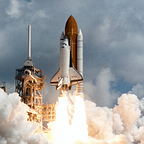The Story of the American Space Shuttle
A success and failure at the same time
The American Space Shuttle is arguably the most complex flying machine of all time. While it was revolutionary at the time of its initial design, many people believe it to have cost many more dollars and lives that it bargained for.
The Components of the Shuttle
The entire mechanism at launch is known as the Space Shuttle, but the spaceplane part of it is the Space Shuttle orbiter. Attached to the orbiter are two Solid Rocket Boosters, (SRB) and an external fuel tank.
The SRBs would be used to get the orbiter and fuel tank off the ground and increase their velocity, but after about two minutes they would fall down to earth and be recovered for later use. From then on, the external tank would provide the necessary fuel for the orbiter’s engines to propel the spacecraft into orbit. When there was no more fuel in the external tank, it would be dropped, to burn up in the atmosphere upon reentry. After that, the orbiter would go on its journey, usually ferrying cargo or people to the space station, launching a satellite, or doing some sort of experiment.
The True Cost of the Space Shuttle
The Space Shuttle was publicly announced by NASA on September 17, 1976. It was publicized as a low-cost way to easily get from earth to space and back. NASA said there would be 2–4 shuttle flights per week, between the 5 shuttles that would be actively flying. In actuality, the flights only took place every 2–4 months, with there being constant maintenance for sometimes years on end in between individual flights.
NASA ended up spending nearly ten times as much as what they originally were planning throughout the thirty years operating the program. Adjusted for inflation, the total price of the program as a whole was around $200 billion. NASA reportedly said there would be an average failure rate of 1 in every 1,000 launches. However, in the end there was a failure rate of 1 in every 67.5 launches.
Why it Was Criticised
In total there were six different Space Shuttles made, five of which flew into space. The first one made, Enterprise just did test flights on earth, it never flew in space. The other five shuttles were Columbia, Challenger, Discovery, Atlantis, and Endeavour.
Many former NASA officials now say the Space Shuttle program was plagued with problems from the beginning. To try to keep on track with what their expectations were for frequency of launches, some shuttles were hastily prepared and maintenanced without proper safety protocol, which many people believe is what led to the disaster of the Challenger and Columbia shuttles.
The Challenger Disaster
For a little bit of backstory, NASA hired originally hired a company called Thiokol to manufacture the SRBs for the shuttle. After the first few flights were a success, NASA engineers started noticing something strange when they examined the SRBs recovered after a launch.
To hold the massive SRBs together, there was tubing on the inside to create a seal. However, after the first few launches they noticed the first of two layers in the seal starting to corrode. They made some temporary fixes and Thiokol got to work improving the design. Unfortunately, they could not fix the problem fully, and many engineers wanted to stop the program for a long period of time to further assess the issue, NASA officials overruled them to adhere to the strict schedule of launches set by the government, seeing as how they were already months behind.
On January 28, 1986 the Space Shuttle Challenger was set to take off. The night before had been a severely cold and wet night, and many engineers were worried about the safety of the astronauts on board. Reportedly, a few Thiokol engineers attempted to contact NASA at the last minute to tell them that the conditions were not safe to launch, but either the message didn’t get there in time or NASA ignored it. When Challenger launched it seemed fine at first, but 73 seconds in, NASA lost communications with the crew and the shuttle was blown up by a huge reaction that was most likely caused from the corrosion of the sealing in the SRBs combined with the cold and wet environment.
The Positives of the Space Shuttle Program
While the Space Shuttle program did have its fair share of issues, it still did some amazing things. The shuttles brought countless capsules into orbit that greatly helped in the construction of the International Space Station, paving the way for many groundbreaking scientific experiments to come. The shuttles have also launched and repaired satellites in orbit. The Space Shuttle program will never be forgotten. While it may be looked on as a failure or waste of money by some, the overall good it has done for science, space exploration, and humanity as a whole is truly unrivaled. We can only hope that something as revolutionary as the Space Shuttle program is around in the future.
